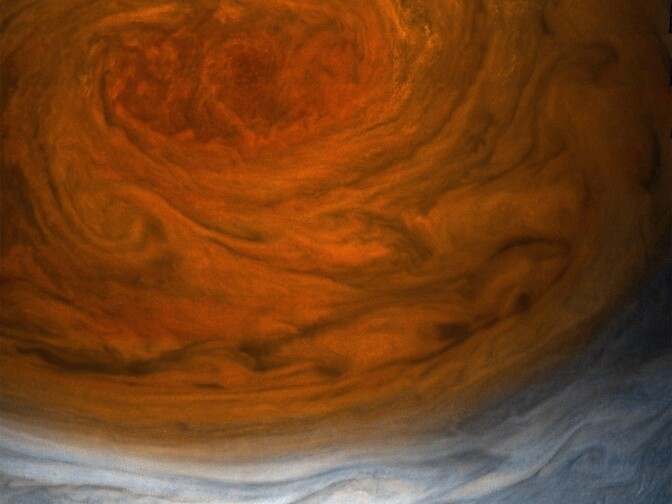With our free press under threat and federal funding for public media gone, your support matters more than ever. Help keep the LAist newsroom strong, become a monthly member or increase your support today.
Jupiter's Great Red Spot as you've never seen it before
This week, NASA's Juno spacecraft passed by Jupiter at about 5,600 miles above the planet's swirling clouds. The flyby allowed the probe to capture the closest images ever taken of the planet's Great Red Spot.
"These are phenomenal, yes. These are knock your socks off," said Glen Orton, senior research scientist at the Jet Propulsion Laboratory in Pasadena, who sat with the images for four hours straight on Wednesday. He's thrilled about the the number of previously unseen features revealed by the flyby that might provide insight into what's actually going on on the gas giant.

He was most excited about the puffy white clouds just North East of the center of the vortex. He's not certain, but they look like thunderstorms, he said.
Orton was also surprised by the presence of smaller storms churning away inside of the Great Red Spot. And that while the spot might look flat in images, each storm takes place at a different depth in the atmosphere -- making the spot really more of a funnel.
In the coming months, scientists at JPL will begin dissecting the data that they received about the spot. Specifically, they're going to try and determine its structure. They'll look at the newly gathered data to try and figure out how deep it goes, the strength of the winds within it and at what level they exist in the atmosphere. They'll also investigate the thermal output of the spot in an effort to determine if the colors observed correspond with specific temperatures.
The Great Red Spot has been churning for at least 350 years and is the largest known vortex in the solar system. But in recent years, it's looked as if the spot is shrinking, and the color seems to be shifting from red to orange.
The Juno mission launched from Cape Canaveral in August, 2011, and after six years and 71 million miles, the probe arrived in early July of last year.
The mission is expected to last until February 2018, which is when the spacecraft will crash in to the gas giant. In the meantime, Juno will complete 37 orbits over the course of 20 months, 12 of which will be close flybys.
The goal is to help scientists better understand how Jupiter formed and the make-up of the planet deep beneath the cloud cover, information that could help us better understand the formation of the solar system.












